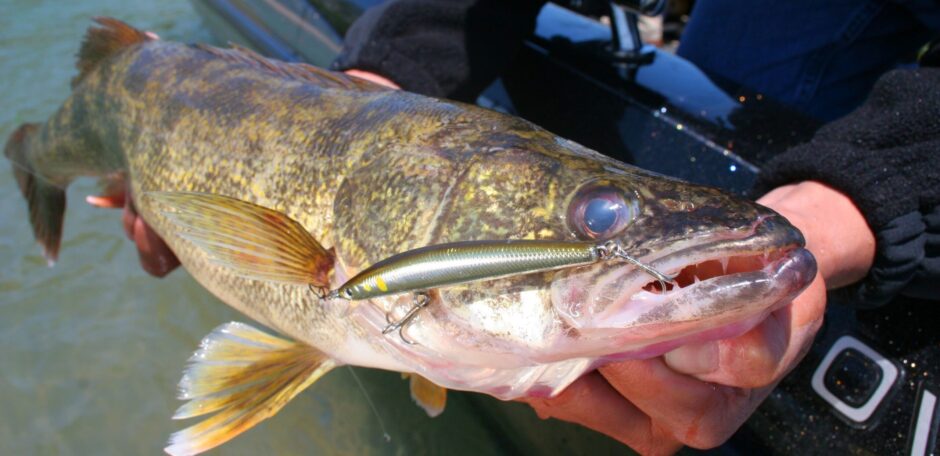
As the ice melts, walleye will start moving towards shallow water in the spring as they get ready to spawn. Reproduction is their main motivation during this time of year. Bulrush beds on shallow points and reefs will hold many fish throughout the spring. Gravel shorelines will also hold many walleye and sauger in the spring. Gravel shorelines exposed to wind will hold more fish than gravel shorelines that are calm. Don’t forget to fish in and around wood. Many walleye are caught in 5 to 6 feet of water holding tight to wood. The pre-spawn bite is usually very good and you can catch plenty of fish in water as cold as the upper 30s. When water temperatures rise into the low 40s to mid-40s, walleye will begin to spawn. In the rivers, walleye and sauger usually travel until their migration is halted by a dam, waterfall or some other type of structure.
Pre-Spawn
The spawning period provides some exciting fishing. In the northern states spawning typically occurs at the end of April, but you can find spawning walleye between mid-April and mid-May depending on the temperatures of that particular year. In the southern lakes, spawning occurs earlier. Fishing is best during the afternoon when temperatures peak for the day. Females typically do not bite once they start spawning, however, they don’t all spawn at the same time. The males can usually be caught somewhat consistently through the spawn. Some walleye fishermen report some very good catches of bigger fish at night during the heart of the spawn. Trolling crankbaits at night can be very effective during the spawn. If you are looking to target the bigger females, get on the water while water temperatures are just climbing into the upper 30s and low 40s and you may get into some huge pre-spawn females. Fishing gets tougher once water temperatures rise into the mid 40 and into the low 50s.
Spawning Time
Walleye can be found in deeper water near their spawning areas. They will stage in 15 to 30 feet of water, but they won’t be feeding aggressively because the water is still cold. Vertical jigging is the easiest way to catch these pre-spawn walleye. Stinger hooks are very popular during the pre-spawn because many walleye will bite short in the cold water temperatures.
As the water warms up and it gets closer to the spawning period, fishing gets much easier. Fish become aggressive and they can be caught in only 3 to 5 feet of water depending on the body of water.
Post Spawn
Once the spawn is over, fishing becomes more challenging for walleye. Some males do hang around their spawning sites after the spawn, but the females will be much deeper and inactive for 1 to 2 weeks. Once these fish recover from the spawn, they will feed heavily. Some fish will move back shallow while others will stay deep. As water temperatures warm, walleye will settle into their summer patterns where they will be found in deeper water most of the day. Once the summer pattern sets in, you will find some walleye feeding in the shallows from 2 to 12 feet of water in the morning, evening and at night, but during the day, they can be as deep as 40 to 50 feet.
Jerkbaits Are Awesome in the Spring
With so many walleye active in the shallows, you can catch a lot of nice walleye by twitching jerkbaits in that 4 to 10 foot depth range on most bodies of water. Cover some water and enjoy all of the shallow water bites.
Swim a Ringworm
With all the active fish in the shallows, you can do well by swimming a ringworm off the points or along the rocky shorelines. Stay in that 4 to 10 foot range on most bodies of water and you’ll do very well.
A Jig & Minnow is Tough to Beat
A simple jig and minnow will be responsible for more trophy-sized walleye than any other type of bait in the spring time. Use a 3.5 to 4.5 inch sucker or chub minnow in a trophy walleye destination and you may have a chance at a 30 incher.
Fish the Green Weeds
The new green weeds will usually hold some walleye early in the year. On some bodies of water, it is the best pattern to fish. On other bodies of water, it is just another pattern to use to put a couple extra fish in the boat. You can find a lot of walleye relating to these newer weeds early in the year and they can often be found quite shallow. Some of these fish will be active in 4 to 8 feet of water only.
Rocky Shorelines Hold Lots of Walleye
A good rocky shoreline with a mix of some shallow and deep water will be a good place to search for active walleye early in the year. After the spawn, you can find a lot of walleye roaming these rocky shorelines to find an easy meal. With water temperatures still low, you can find walleye in 4 to 10 feet of water pretty regularly along these rocky shorelines.
Fish the Major Spawning Areas
On some bodies of water, the walleye may move into the rivers and head towards the dam. On other bodies of water, it might be a huge flat in a bay. On some of the smaller waters, there may not be as big of a migration to the spawning areas, however, on some of the big bodies of water, walleye will swim many miles to a preferred spawning area. Some places, walleye may swim more than 2o miles to a major spawning site. IF you can learn where these areas are, you can do a lot better by fishing these sections of the lakes. Up in Canada, many of the these major spawning sites will be closed to fishing until later in the year. This is to protect the fish during the spawn. However, you can usually fish some areas where the walleye would have to pass on the way in and out of their major spawning areas.


